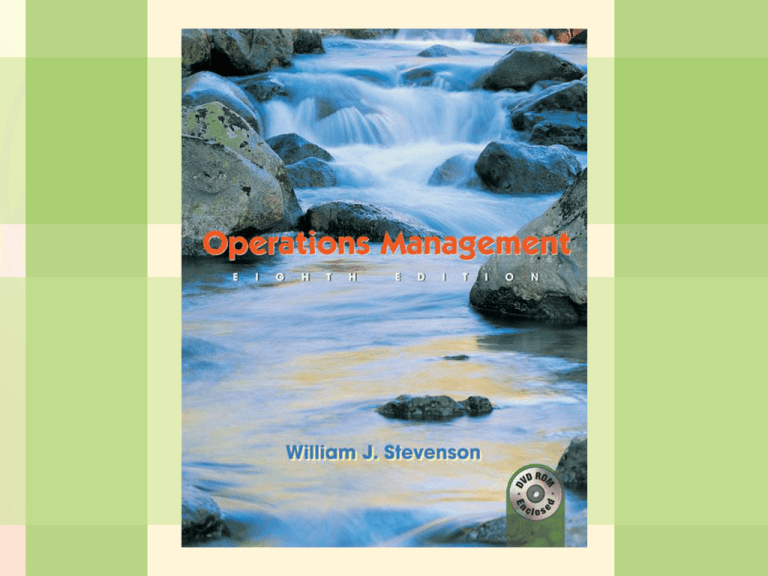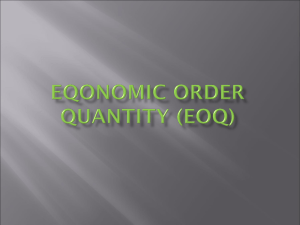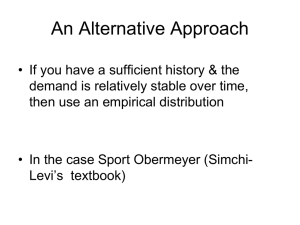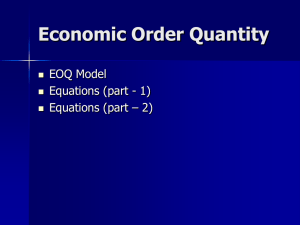
11-1
Inventory Management
Operations Management
William J. Stevenson
8th edition
11-2
Inventory Management
CHAPTER
11
Inventory
Management
McGraw-Hill/Irwin
Operations Management, Eighth Edition, by William J. Stevenson
Copyright © 2005 by The McGraw-Hill Companies, Inc. All rights reserved.
11-3
Inventory Management
Economic Order Quantity Models
Economic order quantity model
Economic production model
Quantity discount model
11-4
Inventory Management
Assumptions of EOQ Model
Only one product is involved
Annual demand requirements known
Demand is even throughout the year
Lead time does not vary
Each order is received in a single delivery
There are no quantity discounts
11-5
Inventory Management
The Inventory Cycle
Figure 11.2
Profile of Inventory Level Over Time
Q
Quantity
on hand
Usage
rate
Reorder
point
Receive
order
Place Receive
order order
Lead time
Place Receive
order order
Time
11-6
Inventory Management
Total Cost
TC= Total annual cost
Q= Order quantity in units
H= Holding cost per unit
D= Annual Demand
S= Ordering cost
Annual
Annual
Total cost = carrying + ordering
cost
cost
TC =
Q
H
2
+
DS
Q
11-7
Inventory Management
Cost Minimization Goal
Figure 11.4C
Annual Cost
The Total-Cost Curve is U-Shaped
Q
D
TC H S
2
Q
Ordering Costs
QO (optimal order quantity)
Order Quantity
(Q)
11-8
Inventory Management
Deriving the EOQ
Using calculus, we take the derivative of the total cost function
and set the derivative (slope) equal to zero and solve for Q.
The total cost curve reaches its minimum where the carrying
and ordering costs are equal.
Q OPT =
2DS
=
H
2(AnnualDemand)(Order or Set up Cost )
AnnualHolding Cost
D
S
Q
Length of order cycle Q / D
Annualordering cost
No. of orders per year D / Q
QOPT=
Q=
H=
D=
S=
Optimum order quantity
Order quantity in units
Holding cost per unit
Annual Demand
Ordering cost
11-9
Inventory Management
EOQ MODEL EXAMPLE
A local distributor for a national tire company expects to
sell approximately 9600 steel-belted radial tires of a
certain size and tread design next year. Annual carrying
cost is $16 per tire, and ordering cost is $75. The
distributor operates 288 days a year.
D= $ 9600 H= $ 16 S= $ 75
a) What is the EOQ? Q = 2DS 2(9600)75 300tires
OPT
H
16
b) No. Of orders per year=D/Q=9600/300=32
11-10 Inventory Management
EOQ MODEL EXAMPLE
D= $ 9600 H= $ 16 S= $ 75
c) Length of order cycle= Q/D= 300/9600
=1/32 of a year*288 =9 work days.
d) Total Cost=Carrying cost+Ordering cost
=(Q/2)H+(D/Q)S
=(300/2)16+(9600/300)75
=2400+2400
=$ 4800
11-11
Inventory Management
Economic Production Quantity Assumptions
Only one item is involved
Annual demand is known
Usage rate is constant
Usage occurs continually
Production rate is constant
Lead time does not vary
No quantity discounts
11-12 Inventory Management
Economic Run (Batch) Size
Qp
2 DS
H
p
p u
I
TCmin Carrying Cost SetupCost max
2
Qp
I max Maxim uminvent ory
( p u)
p
Qp
Cycle tim e
u
Qp
Run tim e
p
Qp=
H=
D=
S=
P=
U=
Optimum production quantity
Holding cost per unit
Annual Demand
Setup cost
Production or delivery rate
Usage rate
H D / Q S
11-13 Inventory Management
Economic Run (Batch) Size Example
A toy manufacturer uses 48000 rubber wheels per year for its popular dump
truck series. The firm makes its own wheels, which it can produce at a rate of
800 per day. The toy trucks are assembled uniformly over the entire year.
Carrying cost is $ $1 per wheel a year. Setup cost for a production run of
wheels is $45. The firm operates 240 days per year.
D= 48000 S=$45 H=$1 per year p=800 wheels per day u= 48000 wheels
per 240 days or 200 wheels per day.
a) Optimal run size
2DS
Qp
H
p
2(48000)45
800
2400wheels
p u
1
800 200
b) Minimum total annual cost
I max
TCmin
Qp
p
( p u)
2400
(800 200) 1800wheels
800
D
I max
1800
4800
S
1
H
45 $1800
2
2400
2
Q
11-14 Inventory Management
Economic Run (Batch) Size Example
D= 48000 S=$45 H=$1 per year p=800 wheels per day u= 48000 wheels
per 240 days or 200 wheels per day.
c)
Cycle tim e
Qp
u
2400wheels / 200wheels per day
Thus, a run of wheels will be made every 12 days.
d)
Run time
Qp
p
2400wheels/ 800wheels per day 3days
Thus, each run will require three days to complete.












